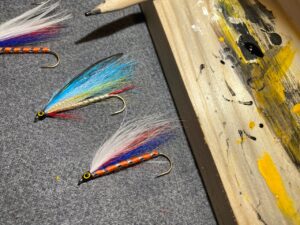Streamer Size Matters

By Ben Rioux
What many anglers fail to realize is that when it comes to smelt imitation (or really any imitation patterns for that matter), size plays a crucial role in the effectiveness of any pattern.
April marks the traditional start of open water fishing in the state of Maine, but as I’ve noted in previous years, northern Maine typically doesn’t get to join in on the fun until at least mid-May, when the ice finally departs our lakes and ponds. Thanks to an abnormally mild winter, however, ice-out looks to be much earlier than in recent years.
Spring usually brings a slew of longtime regulars into camp, as well as a host of new guests hoping to time the smelt run just right on our local lakes and rivers. The sweet spot usually falls somewhere between the last few weeks of May and the first week or two of June. During this time salmon and trout will chase streamers aggressively throughout the water column, and guests get to spend most of their stay fighting fish, instead of the impending black flies that Spring eventually brings.
We’ve talked about some of my favorite streamers and smelt imitations in past columns, and most of those patterns are likely already in your fly box. Maine standbys like the Grey Ghost and Colonel Bates, in traditionally large sizes like 8x long #2, are common menu items for trout and salmon across the state. Their effectiveness has been proven time and time again. In fact, streamers like the Grey Ghost hold so much weight among Maine anglers that when that inevitable slow day does come, many simply refuse to try another pattern and eventually blame everything but the fly for their lack of success.
Carrie tied her famous ghost and other streamers to imitate smelt in the Rangeley Region, but that doesn’t mean that smelt in the Aroostook River, Webster Outlet, or various other parts of the state necessarily mirror those of the Rangeley Region. And while her larger streamers seem to dominate the conversation today, Carrie did in fact tie a wide variety of sizes of the Ghost and other patterns knowing herself that bigger was not always better.
Growing up fishing the lower Fish River in Aroostook County, my fly box was dominated by streamers tied on long shanked size two Mustad streamer hooks. It took me very little time at all guiding at Libby Camps to realize that most of the streamers in my box were simply too large and not appropriate for a majority of the rivers we guide on. The 6X #6 on the other hand is just the ticket. In fact, I would argue that in all but the largest bodies of water in the state, smelt streamers tied on a 6X #6 will out fish their larger counterparts most every time. Don’t believe me? The next time you have a fish that chases down your streamer more than once but refuses to eat it, rest the pool and then throw a smaller streamer in that same spot using the same retrieval.
You’ll be amazed at how many times that fish comes back fully committed and eats your fly. When the fish are active and feeding, especially in the Spring of the year, I have found that even switching to a smaller fly of a completely different color or pattern will produce similar results.
I will never preach that different colors and materials can’t be more or less effective than others, but I truly believe that streamer size plays a larger role by far. If you need further proof, ask ten different people about their favorite streamer. Even in tight knit groups among fishing buddies I would be willing to bet you hear a slew of different answers.
So when you find yourself on the water this Spring cold, fishless, and searching your fly box for that perfect pattern; focus less on the pretty colors and more on hook size. Sometimes less is more, and regardless of what anybody tells you – size always matters.
For more articles about hunting, fishing and the great outdoors, be sure to subscribe to the Northwoods Sporting Journal.
For free access to previous digital issues of the Northwoods Sporting Journal, click here.

